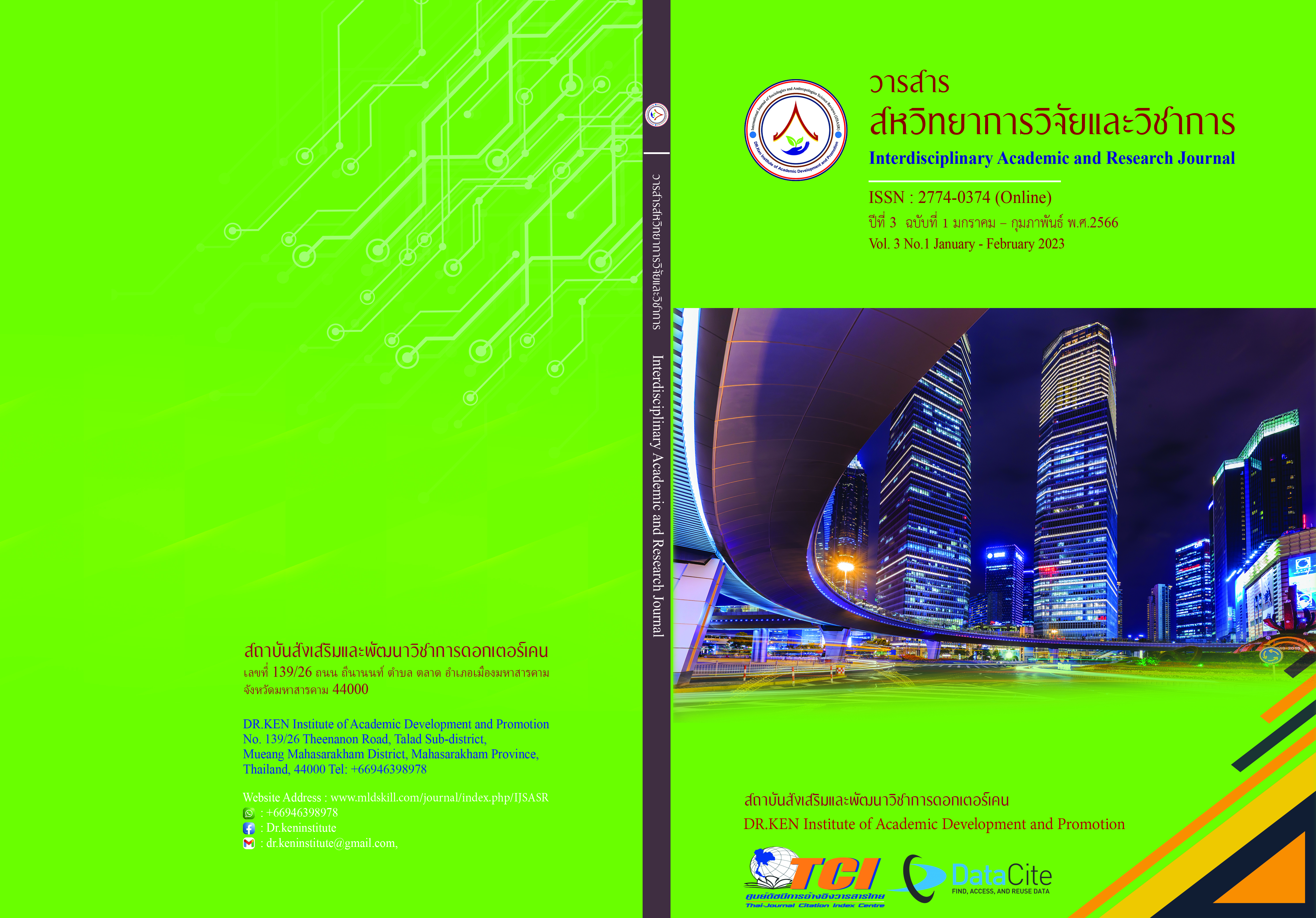Transmedia Storytelling to Create Understanding of People with Visual Disabilities: Case Study of ‘Journey of Memories’ from 'Drama for All' Project from Thai Public Broadcasting Service (Thai PBS)
DOI:
https://doi.org/10.14456/iarj.2023.17Keywords:
Transmedia; , Disability; , Drama for All; , Thai PBS; , New Media; , Public MediaAbstract
At present, Thailand still has limited knowledge and understanding of living with visually impaired people. It can be seen from the access to various welfare of the disabled that cannot be equalized with the general public, for example, access to various media is still limited. This shows that these groups are still being neglected and lack an understanding of coexistence in diverse societies today. The objectives of this research were 1) to study the concept of transmedia storytelling for empathy of visually-impaired person from the drama in the 'Drama for All' Project named ‘Journey of Memories’ from Thai Public Broadcasting Service (Thai PBS); 2) to study the strategies applied in transmedia storytelling for empathy visually-impaired person from the drama in 'Drama for All' Project named ‘Journey of Memories’ from Thai PBS; and 3) to explore the development of transmedia storytelling for empathy visually-impaired person. This qualitative research study aimed to analyze drama contents and compositions in two episodes and 18 transmedia storytelling including in-depth interviews with 5 producers and 5 audiences of the 'Drama for All' Project named ‘Journey of Memories’ from Thai PBS. The research instruments used in this study were content analysis forms and interview forms. The collected data were analyzed by contents categorizing and summarizing. The findings showed that 1) the concept of transmedia storytelling highlighted the design of quality mainstream media before other media and the producers had to understand all the contents. 2) the strategies used in creating this transmedia drama were divided into 3 stages. The pre-production process was to build an understanding of disabled people. The producers had to watch the whole drama to get a depth understanding of the script and then selected the points that are able to create an understanding of the people with visual impairment and benefit society. Planning a suitable time for media publications needs to be a concern as well. The media production process started with designing the process, designing scripts, and then planning to imply the understanding of the disabled people in the drama scripts using short video clips instructed by experts to provide insight and more knowledge. The media design had to be concerned with the suitability of each platform including the selection of images and outstanding letters to draw attention. The post-production process concentrated on video broadcasting via Facebook and YouTube. 3) the development of transmedia storytelling for the empathetic visually-impaired person was to involve all the practitioners to plan from the beginning of the process. Initially, the contents need to be well-designed and correct not only the scripts but also the transmedia storytelling and media facilities for disabled people need to be included. The producers need to learn the correct information about disabled people. The producers were suggested to broaden the transmedia storytelling apart from the drama scripts by creating an understanding of daily routines as a source of knowledge to visually-impaired people and ordinary people, moreover, other audiences should get the benefits from watching this specific drama. Forcing ordinary audiences to understand should be avoided, on the contrary, getting the audiences to acquaint with diversity and establishing a new image for the disabled person need to be done according to the modern era. It was also suggested that Entertainment should be used for presenting. Apart from this, communication for understanding among the ordinary audiences should be concerned too since there is various diversity in society. In addition, the platforms using transmedia storytelling should be used more than online media platforms.
References
จิรศักดิ์ ก้อนพรหม และชนัญสรา อรนพ ณ อยุธยา.(2562). กระบวนการคิดสร้างสรรค์การเล่าเรื่องข้ามสื่อในรายการเดอะแมสซิงเกอร์. วิทยานิพนธ์ปริญญามหาบัณฑิตสาขานิเทศศาสตร์ คณะนิเทศศาสตร์: มหาวิทยาลัยธุรกิจบัณฑิตย์
ธรินทร์วรัช ตางาม.(2559). การเล่าเรื่องข้ามสื่อในยุคดิจิทัล กรณีศึกษาซีรีส์เรื่อง ไดอารี่ตุ๊ดซี่ส์. วิทยานิพนธ์ ปริญญามหาบัณฑิต สาขาบริหารสื่อสารมวลชน คณะวารสารศาสตร์และสื่อสารมวลชน : มหาวิทยาลัยธรรมศาสตร์.
ราชกิจจานุเบกษา. (2563). ประกาศคณะกรรมการกิจการกระจายเสียง กิจการโทรทัศน์ และกิจการโทรคมนาคมแห่งชาติ เรื่อง การส่งเสริมและคุ้มครองสิทธิของคนพิการ ให้เข้าถึงหรือรับรู้และใช้ประโยชน์จากรายการของกิจการโทรทัศน์ พ.ศ. 2563. (16 มีนาคม 2563).ราชกิจจานุเบกษา.เล่ม 137 ตอนพิเศษ 60 ง. หน้า 13-14 และภาคผนวก.
ไพบูรณ์ คะเชนทรพรรค์ และ อุณาโลม จันทร์รุ่งมณีกุล.(2563). กลยุทธ์การสร้างสรรค์เนื้อหา.ประมวลสาระชุดวิชากลยุทธ์การบริหารกิจการสื่อ (หน่วยที่ 4).นนทบุรี:มหาวิทยาลัยสุโขทัยธรรมาธิราช
ศักย์ศรณ์ ศรีประสงค์.(2558). เลิฟซิกเดอะซีรีส์:การสร้างความผูกพันของกลุ่มแฟนผ่านการเล่าเรื่องข้ามสื่อในบริบทชายรักชาย. วิทยานิพนธ์ปริญญามหาบัณฑิต สาขานิเทศศาสตร์ คณะนิเทศศาสตร์ : จุฬาลงกรณ์มหาวิทยาลัย
สกุลศรี ศรีสารคาม, ต่อสกุล ถิระพัฒน์,ระวีวรรณ ทรัพย์อินทร์,อภิสิทธิ์ ศุภกิจเจริญ และญาศิณี เคารพธรรม.(2565). Producer’s Guide to Transmedia Storytelling การเล่าเรื่องข้ามสื่อและกลยุทธ์การสื่อสารหลากแพลตฟอร์ม.(พิมพ์ครั้งที่ 1). Retrieved from: https://issuu.com/thaimedialab/docs/e-book.
Berger, J. (2013). Contagious: Why things catch on. Simon and Schuster.
Cruz, A. & Karatzas, S. (2017). Developing and effective digital presence. In Heinze, A., Flectcher, G., Rashid, T. & Cruz, A. Digital and social media marketing: A result-driven approach. Oxon: Routledge.
Decode. (2021). โลกของคนตาบอดจำเป็นต้องมีเสียงบรรยายภาพ (เสียง) สะท้อนสิทธิพลเมือง. Retrieved June 26, 2021 from: https://decode.plus/20210617/.
Downloads
Published
How to Cite
Issue
Section
License
Copyright (c) 2023 ธารินี อินทรนันท์, สันทัด ทองรินทร์, มนวิภา วงรุจิระ

This work is licensed under a Creative Commons Attribution-NonCommercial-NoDerivatives 4.0 International License.
Copyright on any article in the Interdisciplinary Academic and Research Journal is retained by the author(s) under the under the Creative Commons Attribution-NonCommercial-NoDerivatives 4.0 International License. Permission to use text, content, images, etc. of publication. Any user to read, download, copy, distribute, print, search, or link to the full texts of articles, crawl them for indexing, pass them as data to software, or use them for any other lawful purpose. But do not use it for commercial use or with the intent to benefit any business.
















.png)


